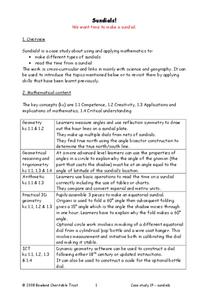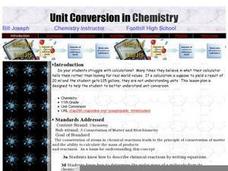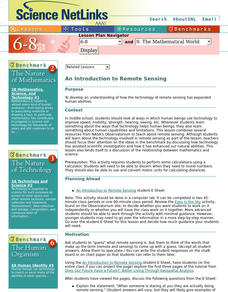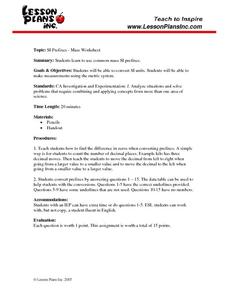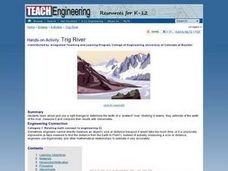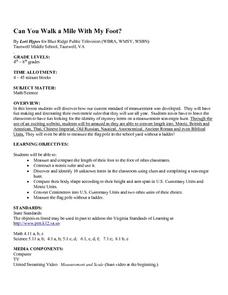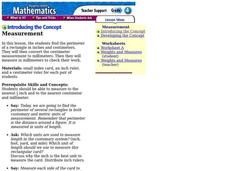Curated OER
Space Flight Simulation
High schoolers engage in the study of flight with the help of a computer flight simulation. They take part in a variety of activities that imitate the Space Shuttle Endeavor. Students work as teams like the astronauts would to complete...
Bowland
Sundials!
Time to learn about sundials. Scholars see how to build sundials after learning about Earth's rotation and its relation to time. The unit describes several different types of possible sundials, so choose the one that fits your needs — or...
Curated OER
Unit Conversion in Chemistry
Hopefully by the time high schoolers are enrolled in your chemistry class, they are skilled with unit conversion. It does not hurt, however, to take an hour early in the school year to review this vital skill. This plan simply provides a...
Curated OER
ExplorA-Pond: 4th Grade Perimeter Estimation
Your geometers are used to finding the perimeter of a square or rectangle, so give them something different this time! With this lesson, small groups will receive a picture of a shoreline and calculate the perimeter. The website listed...
Curated OER
Finding the Area and Perimeter of Polygons
Seventh graders practice finding the area and perimeter of polygons. In this polygon area lesson, 7th graders brainstorm shapes and take a walk to locate shapes. Students record properties of shapes and use various shapes to make a...
Curated OER
Sampling Rocks
Pupils study rocks they find on the playground. In this investigative lesson plan students collect and analyze rocks they find and answer questions about them.
Curated OER
Capacity
Eighth graders explore the term capacity and understand the word's meaning. They participate in several lab stations set up around the room in which they will estimate how many scoops it will take to fill the container. They then will...
Curated OER
Following a Recipe
Students create a cookbook. In this recipe and writing lesson, students brainstorm the skills necessary to follow a recipe, watch a cooking show and write down a recipe used. Students use a word processing program to write a paragraph...
Curated OER
How Fast Is Fast?
Students make sensible estimates and check the reasonableness of the answers. Students write and solve problems involving decimal multiplication and division. Students perform calculations with time.
Curated OER
SI Prefixes and Mass
In this SI prefixes and mass activity, learners are given measurements of mass and they covert to the given measurement by moving the decimal the proper number of places to the left or right.
Curated OER
Leaping!
Students properly leap and measure their distance. For this leaping lesson, students practice leaping for accuracy and proper form. Students estimate their leaps and measure with rulers. Students determine distance covered by the entire...
Curated OER
ExplorA-Pond:4th Grade Perimeter Estimation
Fourth graders visit a real pond. They mark the pond's curvilinear perimeter using string. They measure the string to find the actual perimeter of the pond.
Curated OER
Quilt Squared
Students study West Virginia quilts. In this mathematics lesson, students use symmetry, geometric shapes, and patterns to create their own quilt square.
Curated OER
Trig River
Students calcute distances using trigonometry and angle measurements. They estimate the width of the Trig River, measure it and compare their results with their classmates. They collaborate with a group to research and find the results.
Curated OER
LRO's First Image of Mare Nubium
For this scale image worksheet, students use an image taken by the LRO satellite of Mare Nubium to determine the scale of the image, the diameter of the smallest crater and a comparison scale drawing of a house.
Curated OER
Let the Rain Come Down!
Second graders construct a bar graph comparing local precipitation to that of the Yucatan. In this graphing instructional activity, 2nd graders will use conversions and problem solving strategies.
Curated OER
It's About Time!
Students examine concept of time, and explore difference between analog and digital clocks; students make art project to represent time and create a time-story problem and solution.
National Institute of Open Schooling
Mole Concept
Learners explore atomic measurement in the first activity in a series of 36. Through readings, activities, and questions, classes review standard SI units, learn about Avogadro's constant, and use it to help them calculate moles. They...
Curated OER
Measurement, Perimeter and Area
Learners explore the concept of measurement. In this measurement instructional activity, students collect data about themselves such as height, finger length, neck circumference, foot length, and other body measurements. Learners cut...
Curated OER
Measurement Benchmarks and Conversions
Students explore the concept of measurement. For this measurement lesson, students determine appropriate units of measure for objects in the classroom. Students discuss the importance of measuring objects with the same unit of measure.
Pennsylvania Department of Education
Determine Volume of Solids Using Water Displacement
Young scholars explore math functions by completing math equation worksheets. In this inequality instructional activity, students define a list of math terms and discuss the difference between an equation and inequality. Young scholars...
Curated OER
Can You Walk a Mile With My Foot?
Young scholars engage in a lesson that is concerned with the measurement of a foot as a customary unit. They take part in a series of activities to help them acquire skills of using a foot to compare other units of measurement. The...
Curated OER
Measurement
Fourth graders explore perimeters. In this measurement lesson, 4th graders examine example problems that highlight how to calculate the perimeters of rectangles in inches and centimeters. Students also practice solving problems that...
Curated OER
Spaced Out
The students are able to use a formula to calculate the volume of cuboids by measuring the length of each of the three dimensions. They also investigate the relationship between milliliters and cubic centimeters.



